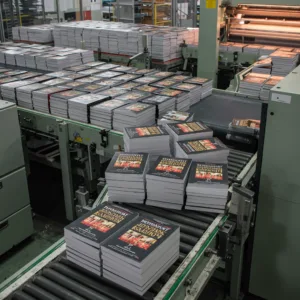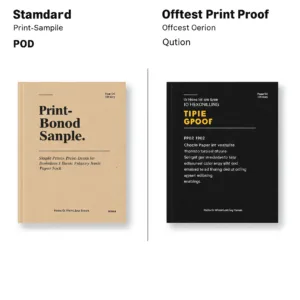Tired of high Print-on-Demand costs eating your author profits? This guide reveals the specific volume threshold where switching from POD to offset printing becomes significantly more profitable. Discover the data-backed breakeven point and strategic factors to confidently scale your book business.
The critical point to switch from Print-on-Demand (POD) to offset printing generally occurs when needing 500 to 1,000+ copies per run. Below this, POD’s lack of setup costs is advantageous. Above this threshold, offset printing’s significantly lower per-unit cost typically outweighs its initial setup fees and minimum order quantity, increasing overall profitability.
In short: Switching from POD to offset printing often makes financial sense above 500-1000 copies, but it’s a strategic business decision balancing cost, quality, risk, and distribution goals. Ready to see the full cost breakdown, risk mitigation tactics, and expert advice to determine if offset is right for you? Read on.
The Core Question: Calculating Your POD vs. Offset Breakeven Point

Table Title: POD vs. Offset: Quick Comparison
| Feature | Print-on-Demand (POD) | Offset Printing |
| Best Use Volume | Low (1+) |
High (500 – 1000+)
|
| Upfront Cost | Low / None | High |
| Cost Per Book | Higher |
Lower (at volume)
|
| Quality/Options | Standard |
Premium / Custom
|
| Turnaround Time | Fast (Days) |
Slower (Weeks/Months)
|
| Main Risk | Lower Profit / Unit |
Inventory / Upfront $
|
Alright, you understand the basic difference (perhaps having read about Offset vs POD: Which Printing Method Is Right for Your Book?), but the big question remains: exactly when does it make financial sense to switch from POD to offset printing?
This boils down to finding the “breakeven point” – the print volume where the cost per book for offset printing drops below the cost per book for POD. Let’s break down how to think about this.
Understanding the Cost Structures
First, you need a clear picture of how costs work for each method:
- POD Costs: This is relatively straightforward. You typically pay a fixed cost per unit to print each book, regardless of how many you sell overall. This cost often includes the printing itself and potentially fulfillment fees or commissions taken by the platform (like Amazon KDP). Shipping might be separate or bundled. The beauty here? It’s a predictable cost tied directly to each sale, with essentially zero upfront investment needed specifically for printing inventory.
- Offset Costs: This is a bit more complex and involves several components:
- Fixed Costs (Setup): These are one-time charges for preparing the print run, mainly for creating the printing plates and setting up the large offset press machines. Think somewhere in the range of $200 to $800 or more, depending on factors that impact book printing prices like your book’s complexity (color pages, cover effects) and the printer.
These costs are the same whether you print 500 books or 5,000 – which is why printing larger quantities drastically reduces the per-book impact of these setup fees. - Variable Costs (Per Unit): This covers the actual materials for each book – the paper, ink, and binding. While these costs are significantly lower per book than POD, they do exist for every copy printed.
- Minimum Order Quantity (MOQ): Offset printers need to print in bulk to be efficient. You’ll typically find MOQs starting around 500 practical copies, though 1,000 is also very common, especially for more complex projects or certain printers.
- Additional Costs: Don’t forget to factor in freight shipping (which can be substantial, especially from overseas), potential customs duties if importing, necessary proofing copies or samples, and potentially warehousing or storage fees if you can’t store the books yourself.
- Fixed Costs (Setup): These are one-time charges for preparing the print run, mainly for creating the printing plates and setting up the large offset press machines. Think somewhere in the range of $200 to $800 or more, depending on factors that impact book printing prices like your book’s complexity (color pages, cover effects) and the printer.
Finding Your Critical Point: The Math Explained
The “critical point” is simply the print volume where offset printing becomes cheaper per book than POD. This happens because offset’s initial, fixed setup costs (like making printing plates) get divided across more books as your print run increases, drastically lowering the cost per copy.
While you can try to estimate this breakeven point using various book printing cost analysis methods, the only truly reliable way forward is to get actual quotes. Provide your book’s exact specifications – trim size, page count, paper type, binding, color requirements – to both your POD provider(s) and several potential offset printers (considering domestic and overseas options like Mainland Printing).
Industry data and experience generally place this breakeven threshold between 500 and 1,000+ copies. To illustrate, one author seeking quotes for just 500 hardcover copies found offset options cost $4.36 to $6.17 per book, compared to their POD cost of $8.41 per book. Even at this lower end of typical offset runs, the potential savings were substantial.
Obtaining these real, specific numbers for your project is the essential first step in making a truly data-driven decision about transitioning from POD to offset printing.
Beyond Cost Savings: The Strategic Value of Offset Printing

While lower per-unit costs are a major driver for considering the switch from POD to offset printing, the benefits extend far beyond just your bottom line. Choosing offset can be a strategic move that elevates your book’s quality, enhances your author brand, and opens doors to wider distribution. Let’s look at why.
Elevating Quality: Tangible Differences Readers Notice
Let’s be honest, the physical quality of your book matters. Offset printing generally offers noticeable improvements that can significantly enhance the reader’s experience:
- Superior Color Reproduction: With proper pre-print color management, offset excels at color consistency across a print run. More importantly, it allows the use of Pantone (PMS) spot colors. Need that exact shade of blue for your branding or a specific character? Offset can deliver it precisely, unlike POD systems which are typically limited to standard CMYK digital color mixing and can sometimes show variations. This is especially critical for art books, photography collections, and children’s books where color accuracy is paramount.
- Wider Paper & Material Selection: You gain access to a much broader universe of paper options for book printing with offset – different weights (thickness), textures (smooth, vellum, linen), coatings (gloss, matte, silk), and specialty stocks, including environmentally friendly choices like FSC certified paper. Want that luxurious, heavy feel for a coffee table book or a specific textured paper for a journal? Offset makes it possible.
- Diverse Binding Options & Durability: Offset unlocks premium binding techniques often unavailable or limited with POD. This includes options like Smyth-sewn binding, which allows books to lay flat when open and is known for its exceptional durability – ideal for cookbooks, manuals, or high-quality hardcovers. You can also incorporate sophisticated finishes like foil stamping, embossing, debossing, spot UV coatings, or die-cuts on your cover to make your book truly stand out.
Customization & Unique Projects: Bringing Your Vision to Life
Do you have a book idea that doesn’t fit the standard POD mold? Offset printing offers far greater creative freedom. Non-standard trim sizes, landscape formats, durable board books for children, intricate pop-up books, volumes requiring special inserts or gatefolds – these are typically feasible only through offset printing.
Building Your Author Brand & Professionalism
Your book is a reflection of your brand. Investing in a high-quality offset print run signals a commitment to professionalism and quality that readers, reviewers, and industry gatekeepers often notice. As many publishing advisors agree, “While reader perception varies, a high-quality offset print run can enhance an author’s brand image and perceived value…”
This perceived increase in quality can help justify a higher retail price, contribute to a more professional author platform, and subtly address the psychological need to move beyond any perceived “amateur” status sometimes associated (fairly or unfairly) with purely self-published POD titles.
Unlocking Wider Distribution Channels
If reaching physical bookstores is a key goal, offset printing often becomes a necessity rather than an option. Here’s why:
- Bookstore & Distributor Preferences: Traditional distributors and bookstores generally prefer working with offset-printed books. They value the predictable supply of inventory that comes with a bulk print run and the potential for standard wholesale discounts (often 50-55%) and established returnability programs, which are crucial for their business model.
- POD Limitations: While POD services like IngramSpark can make titles available to bookstores, the terms offered (often lower discounts and non-returnable status) make them less attractive for retailers to stock speculatively. Offset printing provides the opportunity to negotiate more favorable terms, increasing the chances (though not guaranteeing) physical shelf placement.
Considering these strategic advantages alongside the cost savings helps paint a fuller picture when deciding if the move from POD to offset printing is the right step for you.
Offset Realities: Managing the Risks & Complexity

Making the move from the relative simplicity of POD to offset printing involves taking on new responsibilities and navigating potential hurdles. Understanding these upfront will help you prepare and mitigate risks.
The Upfront Investment: Budgeting Realistically
This is often the biggest hurdle. Unlike POD where you pay as you sell, offset printing requires a significant upfront capital outlay to cover the entire print run (your MOQ of potentially 500 or 1,000+ copies) plus setup fees.
- Cash Flow Impact: This ties up capital that could be used elsewhere in your author business. Ensure you have the funds available before committing, or explore options like crowdfunding or running a targeted pre-order campaign specifically to finance the print run. Don’t stretch your finances too thin.
- Accurate Costing: Make sure your budget includes all potential costs – printing, setup, proofing, freight shipping, customs/duties (if applicable), and potential warehousing – not just the per-book print price.
Inventory Management: Avoiding the “Garage Full of Books”
Suddenly having hundreds or thousands of books arrive requires a plan. This is arguably the biggest operational shift from POD.
- Storage Needs: You need a safe, dry, climate-controlled space to store your inventory to prevent damage. For many authors, this quickly exceeds available space at home.
- Risk of Unsold Stock: If sales don’t meet expectations, you risk being left with unsold inventory, representing tied-up cash and potential waste if the book needs revisions later.
- Solutions:
- Start Conservatively: Consider printing closer to the printer’s MOQ (e.g., 500 copies) for your first offset run, rather than ordering thousands, to gauge sales velocity with manageable risk.
- Third-Party Logistics (3PL): Explore using fulfillment centers (like ShipBob or others mentioned in resources) that specialize in storing and shipping books for authors and publishers. They charge fees, but handle the storage and logistics headaches. Factor these fees into your cost calculations.
Logistics & Lead Times: Patience is Required
Offset printing operates on a different timescale than the near-instantaneous nature of POD.
- Longer Production Time: From file submission to finished books ready to ship can take several weeks, sometimes months, depending on the printer’s schedule and the complexity of your book. Data shows lead times of 12+ weeks are common.
- Overseas Printing Considerations: While potentially offering significant cost savings, printing overseas adds layers of complexity.
Be aware of the true landed cost – factor in potentially long sea freight times (weeks/months), customs clearance processes and potential delays, import duties, communication challenges across time zones, and the critical need for rigorous remote quality control. The initial low quote might not reflect the final cost or the management effort required.
File Preparation: Technical Differences Matter
The digital files you use for POD likely need adjustments for offset printing.
- Color Mode: Offset requires files in CMYK color mode (often with specific profiles like SWOP for the US market), whereas POD platforms frequently accept RGB files. Improper conversion can lead to unexpected color shifts in the final print.
- Resolution & Bleed: High-resolution images (300 dpi) are essential. Proper bleed (extending images beyond the trim line) and safety margins must be set up correctly in your design files.
- File Format: Printers usually require specific print-ready PDF formats.
- Recommendation: It’s highly recommended to work with a book designer experienced in preparing files specifically for offset printing or to utilize templates and guidance provided by your chosen printer. Budget a little extra for potential professional file checks or corrections to avoid costly print errors.
Acknowledging these realities isn’t meant to discourage you, but to equip you. Planning for these factors is key to a smooth and successful transition when you decide POD to offset printing is your path forward.
Making the Leap: A Strategic Decision Framework

Moving to offset printing is a significant step. Instead of relying on gut feeling, use a structured approach to evaluate if the timing and conditions are right for your author business.
Your Self-Assessment Checklist
Ask yourself these critical questions honestly:
- Sales Velocity: Do you have consistent, reliable sales data from your POD performance? Are you consistently selling at least 70% of your target offset Minimum Order Quantity (MOQ) each month, and have you seen this trend hold steady for 6 months or more? (e.g., if targeting a 500-copy offset run, are you consistently selling 350+ POD copies monthly?) Solid data reduces the risk.
- Financial Readiness: Have you realistically budgeted for the entire upfront cost of the offset run, including potential shipping, storage, and a buffer for unexpected issues? Can your business comfortably handle this investment without compromising other essential activities?
- Strategic Goals: Is reaching physical bookstores a primary objective? Is achieving the absolute highest print quality or specific customization essential for this particular book’s success or your brand positioning? Are significantly higher profit margins per unit crucial for your business growth at this stage?
- Book Type Suitability: Does your book’s genre and format (e.g., heavily illustrated children’s book, art/photography book, hardcover needing premium feel) naturally benefit more from the quality and customization options offered by offset?
- Time & Effort Commitment: Are you prepared for the longer lead times involved? Do you have the bandwidth to manage the increased complexity of inventory, logistics, and potentially more detailed communication with the printer?
The Power of the Hybrid Approach (POD + Offset)
Remember, the choice isn’t always strictly “either/or.” Insight: Many savvy independent authors and small presses adopt a hybrid printing strategy, leveraging the strengths of both methods. Consider this:
- Use Offset For: Use Offset For: Your initial launch inventory (perhaps funded by pre-orders or successful book crowdfunding campaigns), fulfilling demand in your primary market (e.g., the US), producing premium hardcover editions, or supplying stock for planned events.
- Use POD For: Making your book available internationally without managing global logistics, ensuring long-term availability (“evergreen” status) without holding inventory, fulfilling one-off online orders after your initial offset stock runs low, or offering different formats (like a paperback POD version alongside an offset hardcover, as seen in Case Study 2 with Sheri Fink).
This approach lets you capture the cost-efficiency and quality of offset for predictable demand while retaining the flexibility and low-risk global reach of POD. It’s often the most balanced and sustainable model for growth.
Choosing Your Offset Printing Partner
If your assessment points towards offset, selecting the right printer is critical. Look beyond just the price quote:
- Quality: Always request print samples, ideally of books similar to yours in spec. Assess their paper stock variety, binding quality, and color consistency.
- Experience: Does the printer specialize in your type of book (e.g., children’s books, novels, art books)? Do they have experience working with independent authors or international clients (if applicable)?
- Communication: Are they responsive, clear, and easy to communicate with? As print expert James Gifford emphasized, “discuss this with your printer…the firm/person who will actually put your project on paper…” Good communication prevents costly mistakes.
- Location: Weigh the pros and cons of domestic vs. overseas printers (cost vs. shipping time/complexity/control).
- MOQs & Turnaround: Ensure their minimum order quantity aligns with your needs and their production timeline fits your schedule.
- Sustainability: If important to you and your readers, inquire about their use of FSC certified paper or other eco-friendly practices.
Taking the time to carefully assess these factors will give you the confidence to make the right strategic move regarding POD to offset printing for your author career.
Conclusion: Is Offset Printing Your Next Strategic Move?
So, we’ve journeyed through the complexities of choosing between POD and offset printing. As you can see, the decision isn’t based on a single magic number, but rather a strategic evaluation of your unique situation.
You need to weigh the potential for significantly lower per-book costs and higher profit margins (once you pass that critical volume breakeven point, often starting around 500-1000 copies) against the necessary upfront investment and the operational demands of managing inventory and logistics.
You should also factor in the tangible benefits offset offers – superior quality, wider customization options, enhanced brand perception, and better potential access to traditional distribution channels – against the undeniable flexibility and low financial risk of POD.
Whether you decide offset is right for you now, later, or perhaps best utilized in a hybrid strategy alongside POD, you’re now equipped with the knowledge to make that choice confidently.







